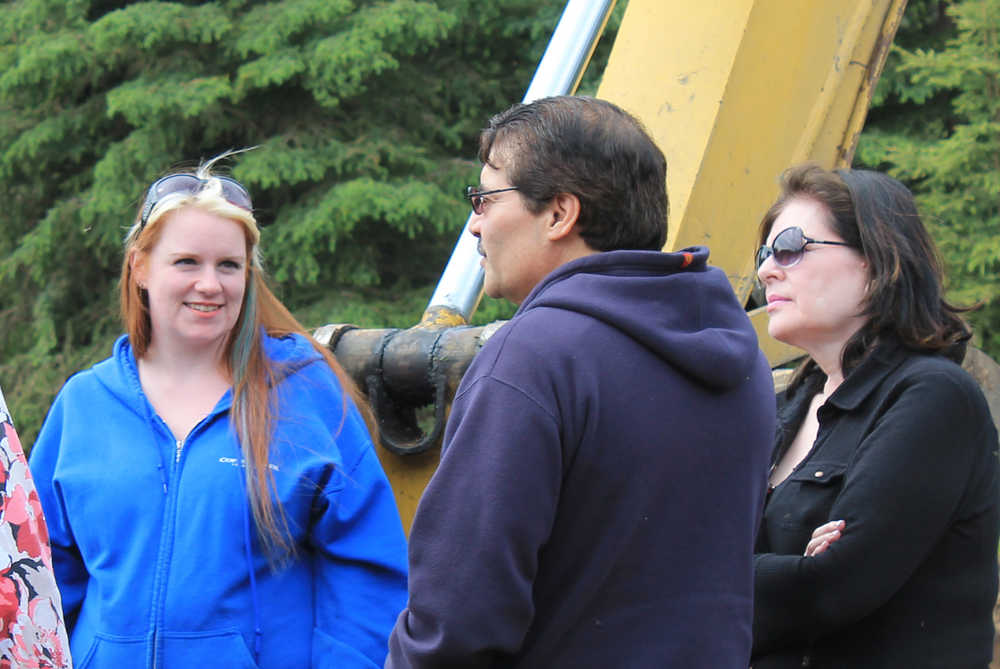Sawdust sprayed into the 66-degree air around Bill Radtke and Nathon Stonecipher as they sliced into a thick strip of wood. After the whirring table saw blade was turned off, the two men paused in their work for a water break.
In a pair of dark reflective sunglasses, Stonecipher sipped from a water bottle on the property of his soon-to-be home. Behind him a rectangular cement foundation jutted up from the ground.
On Saturday, framing work began on this year’s Central Peninsula Habitat for Humanity home on Second Avenue in Kenai.
By Thanksgiving the foundation Stonecipher was overlooking will evolve into a three-bedroom house, said Bill Radtke, board member for the Central Peninsula Habitat for Humanity.
Stonecipher will move into the home with his wife, Crystal Stonecipher, and her three children, Rebecca Trickel, Charles Trickel and Destin Trickel.
“I love everything about it,” Stonecipher said. “Pouring the concrete has been my favorite part of construction so far. It finalizes that it’s actually happening.”
The Stoneciphers married last January after dating for five months. The couple decided early on in their relationship they wanted to start saving up for a house.
The couple was selected to receive this year’s Central Peninsula Habitat for Humanity house immediately after the wedding, Crystal Stonecipher said.
“It would not have been possible for us for a long time if this hadn’t happened,” she said.
The family of five is currently living in a two-bedroom trailer, with a leaky roof and knob-less front door, Crystal Stonecipher said. This winter their pipes froze and the home had no running water for a period of time, she said.
Radtke said the first qualification to receive a Habitat for Humanity home is that the family is found to be living in unsafe or poor conditions. The Stoneciphers’ situation was also considered “overcrowding,” he said.
The kids will be able to play outside at their new home, Crystal Stonecipher said. They will be able to have friends over.
Their future neighbors, also recipients of Habitat for Humanity homes, came to watch the ground breaking, Crystal Stonecipher said.
“It opens up everything for us,” Nathon Stonecipher said.
A qualifying family must also have a steady income, and be able to pay off the cost of the house, Radtke said. Financially the payment process is a no-interest loan, he said.
“If a home costs $100,000 the family will pay $100,000,” Radtke said. “It’s a hand up, not a hand out.”
Once selected, “500 sweat equity hours” must be provided, which the hands of the family or volunteers can accomplish, Nathon Stonecipher said.
Saturday was the first day friends and volunteers were allowed to start helping, said Jeannie Fanning, an Envoy at the Salvation Army, and friend of Crystal and Nathon. She came wielding peanut butter cookies.
Fanning said she doesn’t have much hands-on experience with construction, but she could at least act as a “pack mule.”
Fanning said Central Kenai Peninsula Habitat for Humanity is an organization that is actually meeting the needs of its residents, she said.
The Central Peninsula Habitat for Humanity has the most houses per capita world wide, Radtke said.
However, many Kenai residents still need a new home, Radtke said. This year 19 applications were filed for a house that only one family will receive, he said.
Finding funding and volunteers are two major challenges for every project, he said. Houses can only be built when there is enough money, and how fast a home is built depends on how many volunteer hours are put in, he said.
This year, amidst the business relocation on the Soldotna “Y,” Peggy Mullen, owner of River City Books, let Habitat for Humanity take whatever salvageable materials they could use for this year’s home once the stores were moved out.
Radtke said Habitat for Humanity was able to pull thousands of dollars worth of supplies for the Stoneciphers’ home.
“It is that kind of generosity that makes the Kenai Habitat for Humanity so successful,” Radtke said.
Kelly Sullivan can be reached at kelly.sullivan@peninsulaclarion.com.

